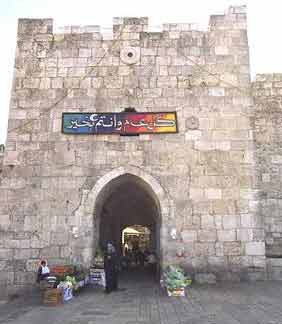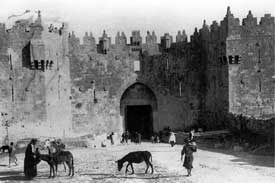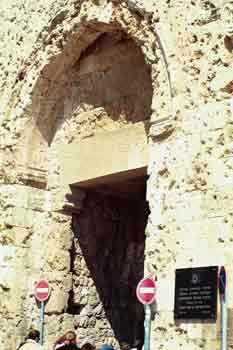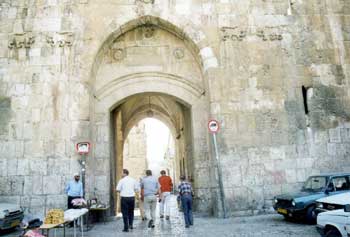Jerusalem Archaeological Sites: The Old City Gates
Jaffa Gate
 Herod's Gate |
The main entrance to the Old City is the Jaffa Gate, which was built by Suleiman in 1538. The name in Arabic, Bab el-Halil or Hebron Gate, means "The Beloved" and refers to Abraham, the beloved of God who is buried in Hebron.
The gate on the western side of the Old City marked the end of the highway leading from the Jaffa coast and now leads into the Muslim and Armenian quarters. A road allows cars to enter the Old City through a wide gap in the wall between Jaffa Gate and the Citadel.
This passage was originally built in 1898 when Kaiser Wilhelm II of Germany visited Jerusalem. The ruling Ottoman Turks opened it so the German Emperor would not have to dismount his carriage to enter the city.
Herod's (Flowers) Gate
The entrance into the Muslim quarter through the northern wall.
 Damascus Gate (c. 1900) |
Damascus (Nablus) Gate
Located on the northern wall, it is the busiest and most magnificent of all Jerusalem’s gates.
The gate consists of one large center gate originally intended for use by persons of high station, and two smaller side entrances for commoners.
New Gate
So named because it was constructed relatively recently - in 1889.
The New Gate was built with permission of Sultan Abdul Hamid II and is located near the northwestern corner of the city. It leads into the Christian quarter.
 Zion Gate (note the bullet marks) |
Zion Gate
Located in the south, this was one of the main gates used by the Israel Defense Forces in 1967 to enter and capture the Old City.
The stones surrounding the gate are still pockmarked by weapons fire. This entrance leads to the Jewish and Armenian quarters.
Dung Gate
Located along the south wall, this gate is closest in proximity to the Temple Mount.
The gate received its name because starting in the 2nd Century, refuse was hauled out of the city through this gate.
Lions' Gate
Located in the east wall, the entrance leads to the Via Dolorosa. Near the gate’s crest are four figures of lions, two on the left and two on the right. Legend has it that Sultan Suleiman placed the figures there because he believed that if he did not construct a wall around Jerusalem he would be killed by lions.
 Lion's Gate (note the dual lions on either side) |
Israeli paratroops from the 55th Paratroop Brigade famously stormed through this gate during the Six-Day War to conquer the Temple Mount, after which they unfurled the Israeli flag above the Old City.
Golden (Mercy) Gate
Facing the Mount of Olives on the eastern side of the Old City, this gate was constructed in the post-Byzantine period.
According to Jewish tradition, the Messiah will enter Jerusalem through this gate. To prevent this, the Muslims sealed the gate during the rule of Suleiman.
 Golden (Mercy) Gate |
Triple Gate
Dating back to the pre-Ottoman era, the three arches of this gate are located in the south wall and are sealed shut.
Double Gate
This entrance to the south wall is sealed shut and also dates back to the pre-Ottoman times.
Single Gate
Constructed prior to the Ottoman period along the southern wall, the now sealed gate led to the underground area of the Temple Mount known as Solomon's Stables.
Sources: Old Damascus Gate, Old Dung Gate, Herod's Gate, Single Gate from Israel's National Photo Collection. Golden Gate, Dung Gate and New Gate photos by Jack Hazut, courtesy of Image-Pro, Torah Educational Software. Zion Gate copyright Mitchell Bard.


